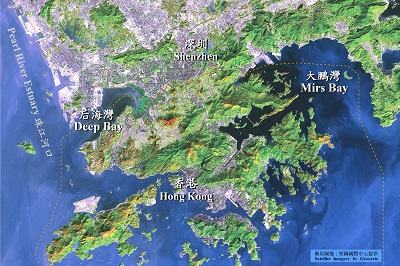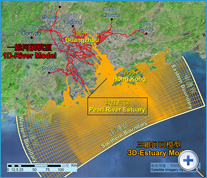This website is designed to help the public appreciate the water quality of our harbours and marine waters, our rivers and beaches, and how we can join hands to protect them from pollution, so that we can continue to enjoy the various water sports and the leisure walk along the waterfront.
We group the topics under several categories in the menu : Water Quality, Sewerage Infrastructure, Legislation & Guidelines, and Regional Collaboration. We also introduce an interactive map through which you can locate more information on the water quality conditions and the rich marine ecosystem and habitats in Hong Kong.
AN OVERVIEW ON WATER QUALITY AND CONTROLLING WATER POLLUTION IN HONG KONG
The State of Our Waters
Water pollution impacts are obvious. Bacteria, excessive nutrients, toxic chemicals and other pollutants can make swimmers sick, contaminate or kill marine life, and give off malodor. Like other major cities in the world, Hong Kong has devoted considerable efforts to improve our water quality. With many of the local industries relocated to the Mainland in the last two decades, the key pollutants come from human sources and livestock farms in the rural area. Pollution abatement measures and programmes have been in place to reduce pollution loads. At the same time, we spare no efforts to retain the unspoiled clean water in the more remote areas.
Our water quality has improved in recent years, but it is not enough for a clean bill of health, particularly in areas like Inner Deep Bay and Victoria Harbour. Further growth in population and our economy will put added pressure on water quality.
For a full account of the quality of Hong Kong's waters, please see Beach Water Quality, Marine Water Quality and River Water Quality.

Improvements Made
There are noticeable improvements in water quality in Hong Kong over the years. The monitoring has recorded that water quality of rivers across Hong Kong has improved substantially, after a series of remedial measures introduced in the late 1980s and 1990s. The number of river monitoring stations with bad or very bad water quality dropped, from over 50% in 1988, to less than 10% in recent years. The EPD has an extensive programme for cleaning up Hong Kong's waters which has had good results. Despite continuous population growth, excellent water quality has been maintained in Port Shelter and Mirs Bay. Overall compliance with the key Water Quality Objectives (WQOs) across Hong Kong marine water has improved from 76% in 1986 to 80% and above since 2002.
The number of beaches meeting the WQO for bathing water was increased to 41 since 2010, compared with 26 in 1997. In other words, all 41 Hong Kong’s gazetted beaches have met the WQO since 2010.
In Victoria Harbour, the first stage of the Harbour Area Treatment Scheme (HATS) to collect and treat the sewage generated around the Harbour was completed at the end of 2001. As a result, the dissolved oxygen in the Harbour has increased by about 10% and the levels of key pollutants in the Harbour have generally decreased. Stage 2A was commissioned in late 2015. Now, all sewage around Victoria Harbour receives chemically-enhanced primary treatment and disinfection.
Water quality improves only when we stop dumping untreated or inadequately treated sewage into the sea and local rivers, streams and bays. The government has a three-pronged approach for dealing with the problem: controlling pollution at source, providing sewers, and collecting and treating sewage.
Controlling At Source
The EPD controls waste water discharges through the Water Pollution Control Ordinance (WPCO). Operators are required to ensure their discharges meet standards specified by the EPD, and specific requirements are contained in the WPCO licences allowing them to discharge their waste water into receiving water bodies. The EPD regularly inspects operators, responds to complaints and will prosecute offenders for violation of the licence conditions.
Providing Sewers
All sewage should be discharged into sewers, not stormwater drains which are only meant to carry rainwater into the sea. The EPD is trying to extend the public sewer networks in the NT and new development areas. The department develops Sewerage Master Plans and the works are carried out by the Drainage Services Department. The EPD also regularly reviews and updates these plans taking account of the development of Hong Kong.
Collecting and Treating Sewage
HATS is a strategy for collecting and treating sewage from both sides of Victoria Harbour. Stage 1 of HATS, which intercepts sewage from Kowloon and part of Hong Kong Island and transfers it to the Stonecutters Island Sewage Treatment Works for chemically-enhanced primary treatment, was brought into operation in late 2001. Stage 2A was commissioned in late 2015, redirecting the remaining sewage from the northern and southwestern parts of Hong Kong Island, which previously received only preliminary treatment, to the newly expanded Stonecutters Island Sewage Treatment Works for chemically enhanced primary treatment and disinfection.
Elsewhere, a collection and treatment system in Tolo Harbour has resulted in a drop in the occurrence of red tides from 43 in 1988 to less than 15 each year in recent years.
Regional Water Quality Management Cooperation
Hong Kong shares its waters with Guangdong. It makes sense, therefore, that pollution control efforts be matched by both sides. Through the then Hong Kong Guangdong Environmental Protection Liaison Group, the Hong Kong and Guangdong Governments formulated in 2000 the “Deep Bay (Shenzhen Bay) Water Pollution Control Joint Implementation Programme” (JIP) to improve Deep Bay’s water quality. Both sides would review the JIP regularly so as to evaluate its effectiveness and to draw up necessary additional measures, including amendment of the JIP. Both sides are working together in accordance with the revised JIP to reduce progressively the pollution load of Deep Bay. The water quality at major rivers discharging into Deep Bay has continued to improve since mid-2000’s. As a result, the water quality of Deep Bay also shows noticeable improvement. In addition, Hong Kong and Shenzhen completed a joint study on the regional water quality control strategy for Mirs Bay in 2003. Both sides would also review regularly the “Mirs Bay Water Quality Regional Control Strategy” to evaluate the effectiveness of the proposed measures and to draw up necessary additional measures. Both sides are continuing to implement the jointly formulated water quality control strategy for protecting the Mirs Bay water environment and meeting the sustainable development objectives.

Also, the Department of Environmental Protection of Guangdong Province and the EPD successfully developed an advanced computer water quality model for the Pearl River Estuary region in 2008. On this basis, both sides completed a study in 2014 using the model to assess the pollution load carrying capacity of the Pearl River Estuary under different water quality targets. This provides a scientific basis for water quality management of the estuary. Both sides are continuing to take forward cooperation and exchange on water quality management of the estuary according to the recommendations of the study.
For more details, please see Regional Collaboration.
Achievements
To achieve the WQOs so as to safeguard the health and welfare of the community and attain various conservation goals, the EPD has implemented extensive programmes such as planning for the provision of sewerage infrastructure, water quality impact assessment in the EIA and planning process, and enforcing pollution control at sources. Over the past two decades, our efforts to clean up Hong Kong's waters have achieved good results.
What You Can Do
Individual operators, such as restaurants and factories, can help to make a difference by complying with the WPCO and related pollution prevention laws. Please refer to Guidelines & References for a full account of compliance guides and good practices.
The Government is actively implementing infrastructure projects. Residents should co-operate with efforts to connect their buildings to sewers. We can also try to reduce our consumption of water, thereby reducing the amount of sewage that needs treatment.
